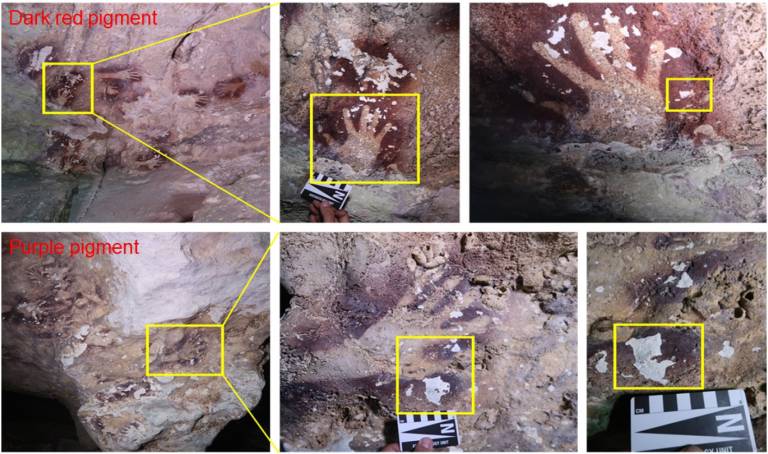Chemical composition of the 40,000 year old Sulawesi Rock Art
10 February 2019
Rock art comprises various forms of images and markings, including paintings, drawings, and engravings, created by prehistoric people on immobile surfaces of rocks.
 In Indonesia, the distribution of rock art sites has been relatively well studied and documented. Indeed, Uranium-series analysis of speleothem materials overlying negative hand stencils and naturalistic animal paintings from the limestone karsts of Maros in southern Sulawesi shows that the rock art in this region dates to at least 40,000 years ago, and is thus among the world's oldest. To our knowledge, the chemistry of the Sulawesi rock art, including that of the pigments used for making these images, and with particular regard to the topology and morphology of these materials, have not yet been systematically investigated. In this study, we report the results of our spectroscopic and microscopic analyses of two samples of pigment collected from rock art motifs at Leang Sumpang Bita 2 in Pangkep, South Sulawesi. The first and second samples possess dark red and purple colours, respectively. Analysis shows that both samples contain iron oxide, which may explain their reddish colours. Nevertheless, microstructural differences are evident, including crystal morphology and size, and, in our view, are responsible for the discrepancy in the observed pigment colours. Our findings suggest that the sampled dark red and purple pigments are from the same raw material source (ochre), but differ in colour because of mechanically-induced alteration, presumably the result of varying pigment-processing methods used by the prehistoric artists.
In Indonesia, the distribution of rock art sites has been relatively well studied and documented. Indeed, Uranium-series analysis of speleothem materials overlying negative hand stencils and naturalistic animal paintings from the limestone karsts of Maros in southern Sulawesi shows that the rock art in this region dates to at least 40,000 years ago, and is thus among the world's oldest. To our knowledge, the chemistry of the Sulawesi rock art, including that of the pigments used for making these images, and with particular regard to the topology and morphology of these materials, have not yet been systematically investigated. In this study, we report the results of our spectroscopic and microscopic analyses of two samples of pigment collected from rock art motifs at Leang Sumpang Bita 2 in Pangkep, South Sulawesi. The first and second samples possess dark red and purple colours, respectively. Analysis shows that both samples contain iron oxide, which may explain their reddish colours. Nevertheless, microstructural differences are evident, including crystal morphology and size, and, in our view, are responsible for the discrepancy in the observed pigment colours. Our findings suggest that the sampled dark red and purple pigments are from the same raw material source (ochre), but differ in colour because of mechanically-induced alteration, presumably the result of varying pigment-processing methods used by the prehistoric artists.
Chemistry of prehistoric rock art pigments from the Indonesian island of Sulawesi
Robi Kurniawan, Grandprix Thomryes Marth Kadja, Pindi Setiawan, Basran Burhan, Adhi Agus Oktaviana, Rustan, Budianto Hakime, Maxime Aubert, Adam Brumm, Ismunandar
DOI: 10.1016/j.microc.2019.01.001
 Close
Close

